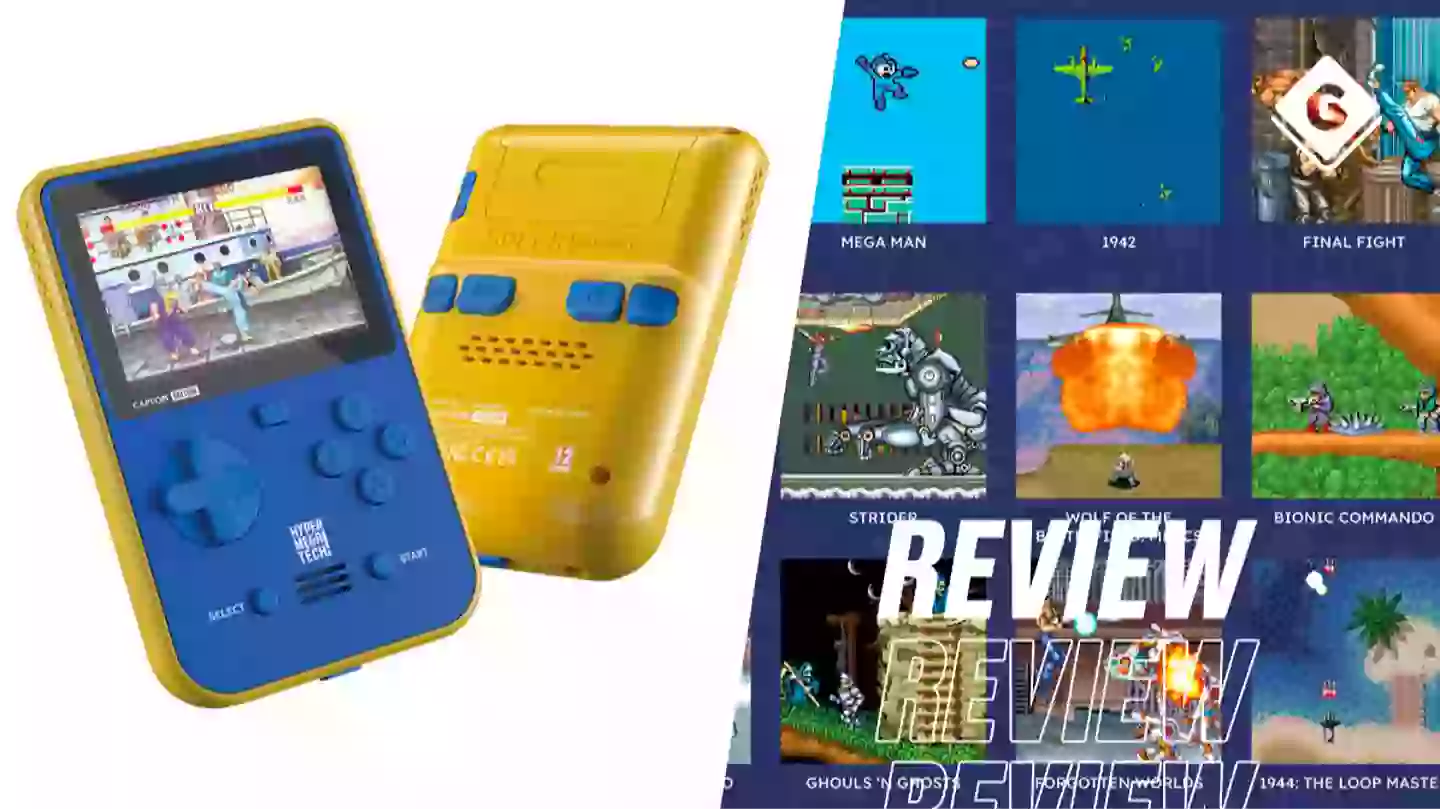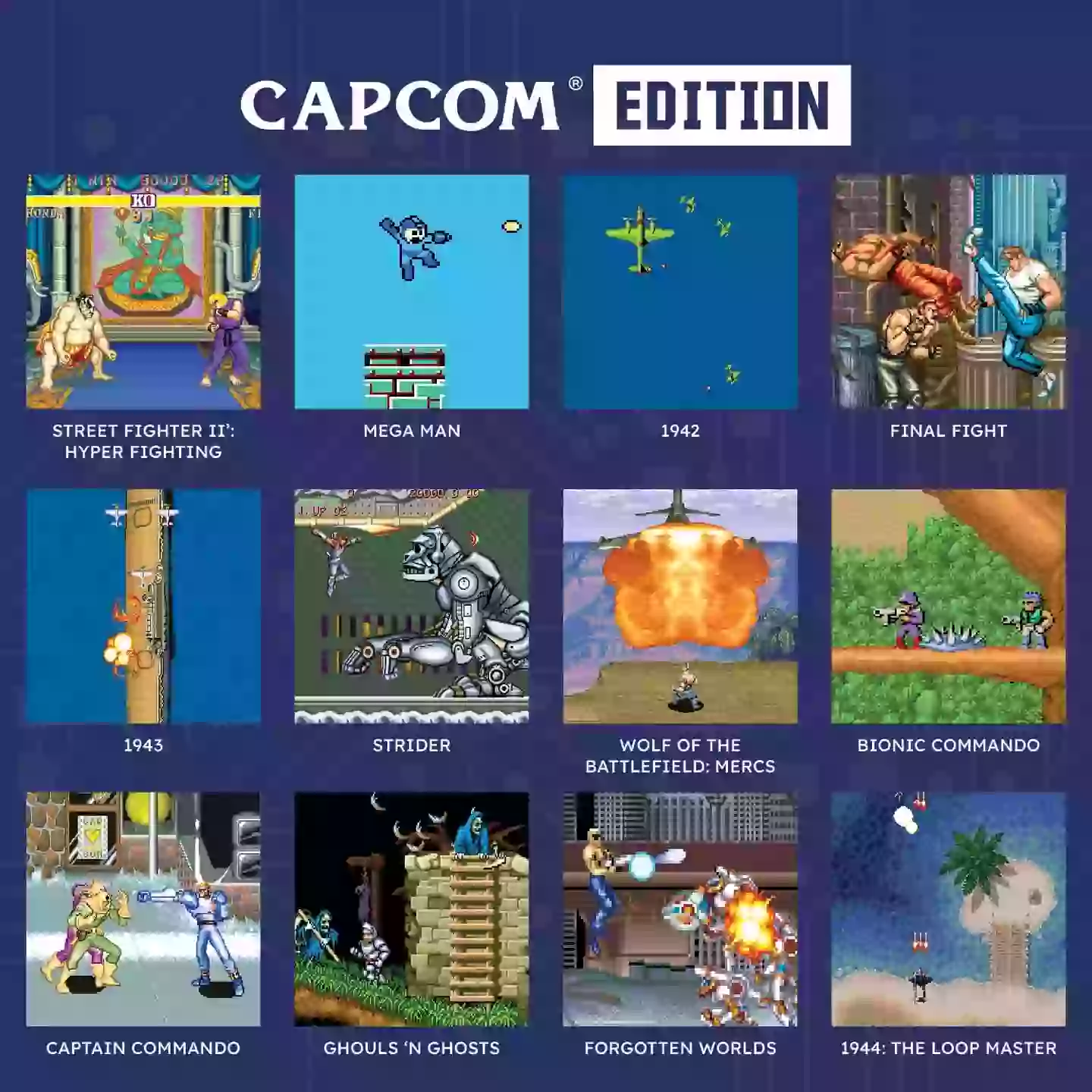
The Super Pocket is the perfect choice for casual gamers, young and old, who want to play some classic video games compiled into a neat and affordable package.
As someone who adores retro gaming and regularly expands my collection with new (old) consoles and games, I can't lie, the Super Pocket piqued my interest as soon as I saw it.
Check them out for yourself via the below trailer!
Modelled after the now iconic Nintendo Game Boy, the Super Pocket is a handheld device that gave me plug ‘n play vibes. You know the type I'm talking about: miniature consoles that house a collection of games you can play practically anytime in any place, without having to cart out a big box and mess around with a load of wires to get it going.
Advert
The catch with the Super Pocket is each version of the handheld is themed around a particular developer. I played around with the Taito and Capcom variations and while my favourite would have to be the Capcom offering, I can tell these will appeal to a lot of different types of people, so it's nice to see Hyper Mega Tech catering to the different markets.
Starting with the design of the handhelds themselves, they're modelled after the Nintendo GameBoy as I said before, but with little flickers of style added in. Both versions had big splashes of colour, with the Capcom's sporting that classic yellow and blue colour scheme, whereas Taito went for the bold choice of black and cyan, which I wasn't keen on at first but it's grown on me since.
The button layout will be familiar to anyone who's used a classic controller before, a D-pad and four main buttons, along with a start and select button at the bottom. There are also four triggers on the back for the games that require some extra input. Volume can be adjusted via two buttons on the side of the handheld, though even on the lowest volume setting the device seemed loud, which is something to keep in mind if you plan on playing it whilst you’re out and about. There’s also a central menu button which will give you access to various features and settings to play around with.

Advert
I was particularly impressed with the LED screen, which beautifully showed off the games without upscaling them to the point where the picture quality suffered. While the 8-bit and 16-bit style of games has aged gracefully over the years, sometimes cleaning up their visuals too much can make them look odd, so it's good to keep them looking as authentic as possible. The screen does a great job though so I have no complaints there.
That being said, and like most retro collections, the display can be tweaked depending on your preference. By navigating to the display menu, you can add in scanlines and choose how prominent you’d like them to be on screen, switch up the aspect ratio from the original to fullscreen, or go for a pixel-perfect look for your games. They’re minor changes, but I always appreciate them being added, especially since I always try to make them look as close to the real deal as possible, scanlines and all.
The games all benefit from a feature I’d argue to be an absolute necessity in any retro game on a modern system, save states. Games should be fun, and while you can adjust the difficulty of Super Pocket titles via the main menu, that doesn’t mean each game will be a cakewalk, after all the majority are arcade games made purposefully challenging to get you to spend more money on them. Even the games that came from consoles were tough because they needed to justify why a game any skilled player could beat in less than an hour cost so much to buy.
Save states let you save a moment in the game which you can load back into later on, whether it be the start of a level, a room before a particularly tough boss battle, or just your favourite levels. For games like Ghouls ‘n Ghosts this is a godsend, as no one wants to start a game from scratch after running out of lives, they didn’t want to back then and they certainly don’t want to in 2023, so its inclusion is great to see.
Advert
Now onto the meat of the handhelds: the games. After all, you’re not buying one of these for it to sit on your shelf and look pretty,.If you are that’s weird.
We'll start things easy and cover the Taito model first, which boasts 18 lovely arcade titles.
The full list includes:
Bubble Bobble
Advert
Space Invaders
Space Invaders 91’
Operation Wolf
The New Zealand Story
Advert
Rastan
Cadash
Chack’n Pop
Don Doko Don
Elevator Action
The Fairyland Story
Football Champ
Growl
Kiki Kaikai
The Legend of Kage
Liquid Kids
Volified

These are all classics, and well-deserving of a spot on the list, though I wouldn’t expect anyone to spend hours of their time on a single game. These are arcade games, after all, meaning you can’t go in expecting fully-fledged adventures. They’re microgames where you aim for a high score or try to get further than you did the last time you played it, and there’s no better way of putting that.
That being said, this isn’t a criticism, as I’d say the arcade titles lend themselves very well to a portable device, and after playing through everything else the Taito Super Pocket had to offer, I was more than satisfied with the variety of the selection. While I played the Capcom Super Pocket more, for reasons I'll get to in a minute, I found the Taito version to be a great choice for when you're on the go. It’s a great little time killer, which I stored in my bag for long public transport rides to and from the office during the week. While I’d only play it in small bursts of around 20-30 minutes, it was always a lot of fun and I’d say the quantity and quality of games make the overall price fair.
Moving onto the Capcom Super Pocket though, despite playing this one a lot more, I had a few more gripes with it.
The game selection for the Capcom version includes:
1942 (Arcade version)
1943 (Arcade version)
1944: The Loop Master (Arcade version)
Bionic Commando (Arcade version)
Captain Commando (Arcade version)
Final Fight (Arcade version)
Forgotten Worlds (Arcade version)
Ghouls ‘n Ghosts (Arcade version)
Street Fighter II: Hyper Fighting (Arcade version)
Strider (Arcade version)
Mega Man (8-bit)
Wolf of the Battlefield: Mercs

Despite having slightly less quantity, there’s just as much quality if not more. The games here also benefit from the same bells and whistles of the Taito model, like the display and difficulty adjustments. This version is also where save states are most useful, mainly because most of these games are comprised of actual levels rather than aiming for a high score, like Mega Man.
I played this version quite a bit, beating Mega Man for the umpteenth time and getting pretty far in games like Bionic Commando, Captain Commando and Street Fighter II: Hyper Fighting.
All the games looked, sounded and controlled beautifully, and again there was more than enough variety included for the price, with the extra adjustments being the cherry on top, once again lending itself to on-the-go gameplay.
My only gripe is while the game selection was good, it’s nothing new. There wasn’t much to encourage me to play this version at home if I had any other games console, as there are several retro Capcom games available in digital stores, either as standalone re-releases or as part of collections. I could even play the majority of these games portably via the Nintendo Switch in handheld mode.
If the selection featured a few games we hadn’t seen already, there’d be more appeal for this one, as it’s a problem the Taito version doesn’t have since the majority of its games aren’t as easily accessible on other systems.
If you don’t own any other game consoles, then this will be worth considering, but if you do there isn’t much about this handheld that screams “must-have,” unless you’re desperate to take these games on your travels and don’t want to risk taking your Nintendo Switch or Steam Deck outside.
The last thing worth mentioning is that you can expand the games you’re able to play through Evercade cartridges. The one I was given was the IREM Arcade 1 featuring:
R-Type
Moon Patrol
10-Yard Fight
Battle Chopper
Lightning Swords
In The Hunt

I wasn’t as into these games as I was with the other ones, but I can recognise them for what they are, more games to play on the go. That they were all ones I’d never played before was an added bonus.
Getting them to work with the handheld was straightforward too, simply requiring you to take off one of the back panels and slide the cartridge in. Then it’s simply a case of navigating through the menus to the six extra games and it’s business as usual. Once again you get all the bells and whistles like save states, display settings etc, and it’s a nice way of adding more variety to the collection.
Overall, I think both Super Pockets are worth consideration for any retro gaming fan, or those interested in experiencing gaming history. Are they as good as playing the genuine article? I’d say no, but that’s not why you’d pick one of these up. For more casual fans who don’t want to spend their hard-earned cash on original systems, games and monitors capable of playing them, these Super Pockets are a fabulous option and are decently priced too.
There are currently two variations of the Super Pocket, the Taito one and the Capcom one, though it’s more than likely there’ll be more in the future. Personally, I’m hoping for a SEGA variation, because Sonic The Hedgehog 2 hasn’t been re-released enough yet.
Topics: Retro Gaming